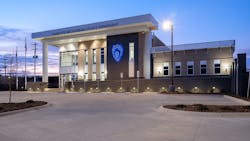Open and inviting are not the first words used to describe public safety facilities. Yet, of the many services public safety buildings provide, one of the most visible in the community is the lobby access. The recent trends in public safety, such as being more open to the community with community meeting rooms and often sharing space with other government offices, do not decrease the need for safety and security considerations but make the design more of a community concern and focal point.
The myriad functions and needs of a public safety facility make the design unique to each agency. And that uniqueness dictates the types of technology needed for the facility. Considering most agencies have occupied their public safety building for 40+ years, it’s impossible to know what will be needed that far in the future, but a solid plan with the option to grow and change along the way is always a positive.
Planning for technology
The Police Facilities Planning Guidelines published by the International Association of Chiefs of Police include four phases covering the design and construction stages. While each stage is important, the second phase of planning and pre-design is essential when considering the building's current and future technology needs. Equipment storage spaces for servers, routers, controllers, racks to mount all the equipment, and cooling and security for the area are also critical components of building technology.
The space needed for planning includes current equipment storage, new facility technology storage, and building security equipment needs. Backup systems and redundancy also need to be considered. Will the building have a generator, and if so, what size is needed to run the critical systems, and for how long? What size Universal Power Supply (UPS) is needed for the equipment stored on-site? Are the servers backing up data to the cloud via a secure network, physical backups, or mirrored to another server in a different location?
Security technology
Including physical security systems, such as card readers, security cameras, access-controlled entries, gates, and sally ports, is important. Setting clearly defined security zones and controlling access is vital to security and the safety of staff and others in the building. Focusing on control as one of the main components of the planning includes how the building should optimally operate while keeping everyone safe.
Building plans should also include aspects of cyber security when determining the technology design and Internet and intranet connectivity. Along with cyber security plans, a public safety facility design or upgrade must plan for wired or wireless connectivity on site, other government buildings, and the Internet. And those connection points must be secured to minimize physical and cyber breaches.
Site security
Site security and control are critical with the diverse population served at public safety facilities, especially those co-located with other government services. Limiting unsecured access to areas in the building, creating setbacks, and optimizing security cameras are all needed to ensure the safety of the building and those inside.
The U.S. General Services Administration (GSA) has guidelines for site security design that apply to federal public spaces. However, these design guidelines are also relevant when building or upgrading public safety buildings, especially buildings that incorporate public spaces, like community meeting rooms and outdoor gathering spaces. Creating safe and secure facilities while remaining open and available to the public through welcoming design is not as difficult as it may seem.
Long-term planning
Well-designed public safety facilities are safe and secure for everyone and should also be welcoming to the community, users, and staff. And that security needs to translate to the technology and control aspects of the building. Planning the best use of space based on the functionality, staffing levels, and predicted growth helps keep those who use the building safe.
The same planning should be used for building upgrades and remodels. As policing systems are added and updated, the facilities that house those systems should be reviewed to determine where extra equipment will be housed. The current backup systems, including the UPS, and external redundancies like generators should be considered. Most importantly, how can the building handle the new technology?
We should all remember as much as technology gets smaller as it improves, more and more systems and technology continue to be added to the repertoire of public safety. Many older buildings do not have effective storage for body-worn cameras, not to mention other technology that requires storage.
About the Author
Toni Rogers is a freelance writer and former manager of police support services, including communications, records, property and evidence, database and systems management, and building technology. She has a master’s degree in Criminal Justice with certification in Law Enforcement Administration and a master's degree in Digital Audience Strategies.
During her 18-year tenure in law enforcement, Toni was a certified Emergency Number Professional (ENP), earned a Law Enforcement Inspections and Auditing Certification, was certified as a Spillman Application Administrator (database and systems management for computer-aided dispatch and records management), and a certified communications training officer.
Toni now provides content marketing and writing through her company, Eclectic Pearls, LLC.
About the Author
Toni Rogers
Toni Rogers is a freelance writer and former manager of police support services, including communications, records, property and evidence, database and systems management, and building technology. She has a master’s degree in Criminal Justice with certification in Law Enforcement Administration and a master's degree in Digital Audience Strategies.
During her 18-year tenure in law enforcement, Toni was a certified Emergency Number Professional (ENP), earned a Law Enforcement Inspections and Auditing Certification, was certified as a Spillman Application Administrator (database and systems management for computer-aided dispatch and records management), and a certified communications training officer.
Toni now provides content marketing and writing through her company, Eclectic Pearls, LLC.

